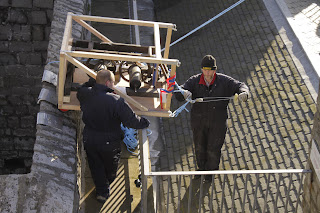Now that we can see things more clearly we are beginning to form a picture of the restoration history of the clock.
In a turret clock such as this, the movement of the big wheels is transferred one to another by little ones called pinions. These pinions take a lot of the stress during the operation of the clock and tend to wear out. It is quite clear that all six pinions in the Castle Rushen clock have been replaced at least once because they are of 18th/ 19th century design and, in fact, most look even more recent than that; they are of very poor quality, are poorly aligned, and are badly worn as a result. We intend to replace all six pinions with superior, bespoke cast iron leaf pinions that are more in keeping with the age of the clock.
There are a number of other matters to attend to that I shall describe in due course. Meanwhile, we have noticed that the escapement is set in a separate frame, dovetailed into the main frame. It can be removed whole without dismantling any of the movement. Such a feature would only be useful if the escapement had been changed in the past, lending weight to the theory that the Castle Rushen Clock dates from the 16th century and was originally regulated by a verge and foliot escapement.






